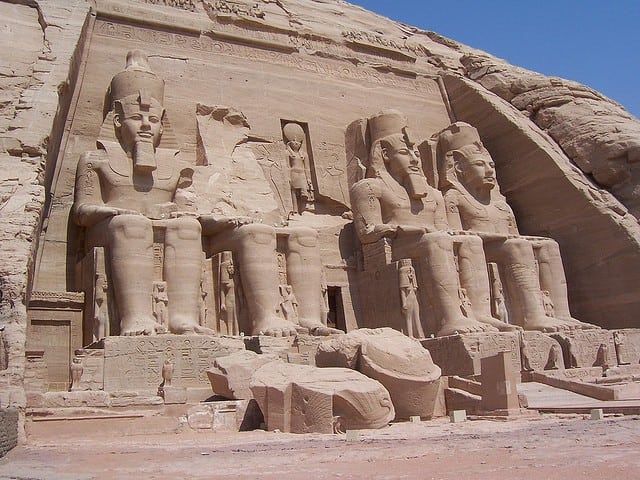Abu Simbel is basically a small settlement in Nubia, South Egypt. The area, which is also a UNESCO World Heritage site is renowned for being home to the two massive rock temples, The Great Temple and The Small Temple, also known as Nubian Monuments. Dedicated to Pharaoh Ramses II and his queen Nefertari, the twin temples were constructed to commemorate his alleged victory at the Battle of Kadesh. The construction of the temple complex started in 1264 BCE and the entire process lasted for about 20 years. The temples at Abu Simbel, which continues to remain among the top tourist attractions of Egypt are considered to be the grandest commissioned during the reign of Rameses II out of the six rock temples he erected in Nubia. The temple complex at Abu Simbel was discovered in 1813 when Johann Ludwig Burckhardt saw the upper parts of the colossal figures inside the temple, accidentally. Set in the solid rock above the banks of the Nile River, in The Great Temple, the four seated statues of Ramses are approximately 20 metres in height. The temple is dedicated to the most important gods of the New Kingdom, Ptah (the creator god of Memphis), Amun-Re (the great god of Thebes) and Re-Harakhte (sun god of Heliopolis), as well as to the Pharaoh Ramses II himself. Significantly, at the feet of Ramses stand the statues of his favorite children. The interiors of the temple depict scenes which show Ramses’ greatness in battle of Kadesh. Interestingly, the axis of The Great Temple was positioned by the ancient Egyptian architects in such a way that on October 22 and February 22, all sculptures would get illuminated except for the statue of Ptah. These dates are known to be the king’s birthday and coronation day respectively and are celebrated with great fervour here. The Small Temple, built to the north east of The Great Temple was dedicated to the goddess Hathor and Ramesses II’s wife, Nefertari. Nefertari was particularly special for Ramesses II, as her temple represents the second time in Egyptian history that a temple was dedicated to a queen. What further enhances the charm of the twin temples at Abu Simbel is the fact that between January 1966 and September 1968, the temples were saved in a massive archaeological rescue plan sponsored by UNESCO in the 1960s, in order to protect them from the rising waters of Lake Nasser. The temple was carved into a thousand pieces, raised over 200 feet and then reassembled on an artificial hill above the reach of Lake Nasser. In order to reach Abu Simbel, the first thing is to reach Aswan by flight. From Aswan, the village of Abu Simbel lies at a distance of 280 km. By air, there are daily flights to Abu Simbel from Aswan. Another good option is to take a coach or minibus from Aswan, travelling in police convoys. This is the only way to access Abu Simbel by road as private vehicles aren’t allowed due to security reasons. For the adventurous ones, there is the option of travelling by cruise ship from Aswan through Lake Nasser to Abu Simbel. Thus, there is no dearth of options to access Abu Simbel. So go ahead, and plan a historically rich trip to Abu Simbel in Egypt!
travelbout is the best travel and tourism guide for each and every geek traveler. Here you will get all the information regarding best holiday destinations and hot places to visit around the world. We will also give you the idea about the different issues and subjects which can cause any kind of problem to the travelers.
© © 2024 Xaprio Solutions













